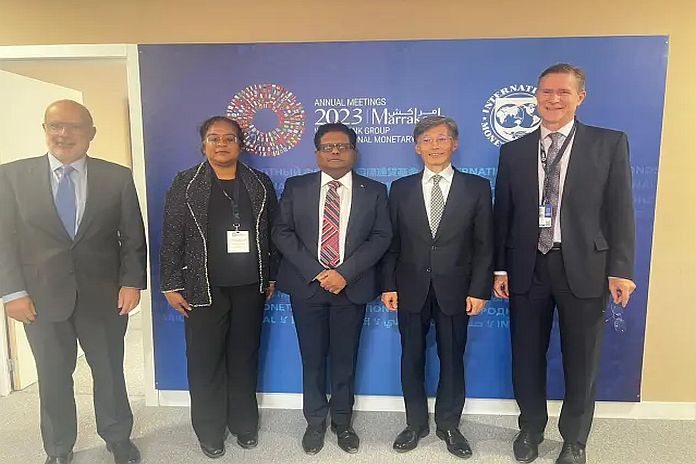GUYANA / MOROCCO, (DPI) – As the International Monetary Fund (IMF) and World Bank Annual 2023 Meetings continue in Marrakesh, Morocco, senior finance minister Dr Ashni Singh assured IMF’s deputy managing director (DMD) Kenji Okamura during a meeting, that the government of Guyana is committed to continued prudent and sustainable management of the country’s economy.
Dr Singh highlighted that Guyana’s economy recorded real economic growth of more than 40 percent on average per annum over the last three years, with medium-term growth projected at more than 20 percent on an average annually. Okamura recognised Guyana’s strong economic performance and economic policy agenda.
In its just-released Regional Economic Outlook Report for the Western Hemisphere, the IMF noted that Guyana should record a 38.4 percent real Gross Domestic Product (GDP) growth rate this year while the country’s growth should continue with an expansion of an expected 26.6 percent in 2024. The report also indicated that Guyana is the only country in which double-digit growth is expected.
“Guyana’s economic circumstances and economic story are very unusual. There are very few relevant comparators for what we are achieving and what we are experiencing in terms of the economic growth and the rapid economic transition that we are going through. There are very few, if any, historic precedents for this kind of growth,” The finance minister pointed out during the discussion with the IMF’s DMD on Sunday.
Dr Singh however indicated that Guyana’s success story should not only be confined to recent years but should be viewed through a ‘long window of our economic performance’. It was here that the finance minister explained that Guyana has moved a long way from the unfortunate economic position it had in the past.
“We come from a time when Guyana was once one of the most heavily indebted poor countries in the world. There was a time when Guyana’s debt to GDP ratio was more than 600 percent and it took hard work to get us from where we were as a Heavily Indebted Poor Country (HIPC) with debt to GDP exceeding 600 percent and debt service to revenue exceeding 100 percent to bring us to a point where our debt to GDP ratio was about 60 percent and that is before we started producing oil,” Dr Singh explained to the IMF official.
He reminded that there has been a sustained policy effort by the current administration to ‘open up the economy, to transition it from essentially an economy dominated by government and state activity to an economy that is driven by private investment, both foreign and domestic, that reflects openness, both in terms of openness to external trade and a truly open and competitive private sector economy domestically, and creating the conditions that are necessary to attract big international investors from around the world’.
Alluding to Guyana’s Low Carbon Development Strategy (LCDS) under which Guyana is now selling carbon credits to the world, Dr Singh reminded that Guyana became the first country in the world to get jurisdiction scale certification of its forest and concluded its first sale transaction under the second generation of the LCDS, the first of which he noted too had commenced under the People’s Progressive Party/Civic in previous years.
The finance minister then reiterated government’s intention to continue to manage the economy in a prudent, sustainable manner to continue the success through among other approaches, creating a successful diversified non-oil economy.
“Our intention is not to be an economy solely dependent on oil. We are using this period to make the strategic investments that are necessary to ensure that in the medium to longer-term Guyana is not an economy that is solely dependent on oil. We want to make sure that we have a growing, globally competitive non-oil economy so we are using this period to invest in things like infrastructure to improve connectivity with our neighbours, increase the economic space in which we are operating, and therefore lay the foundation for more trade…”, the minister posited.
He added as well that as such, the government is working on building out a road to Brazil, building a bridge to Suriname, promoting the Caribbean Economic Integration agenda under the Caribbean Community (CARICOM) and fast-tracking initiatives to advance economic integration in specific areas like food security with Guyana having a ‘comparative advantage in areas like agriculture’.





